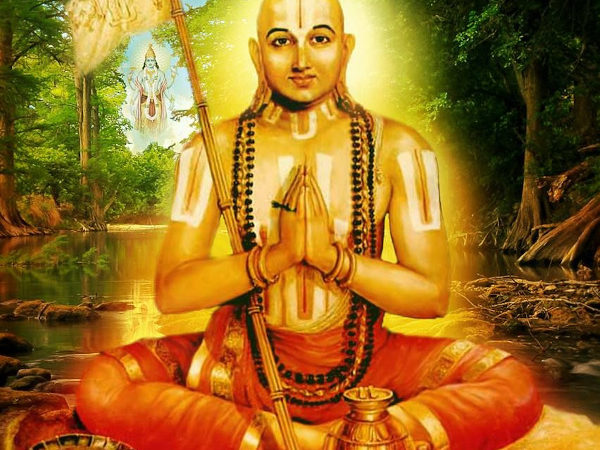Recently Shri Nishchalaland Ji Sarawati; Shankaracharya of Govardhan Math Puri has made a statement about Shri Ramanujacharya and Swami Dayanand. According to him, Swamy Dayanand followed the theories and interpretation of Ramanujacharya, except Avtar and Idol worship. Nishchalanand Ji is very much correct but there is a very a little glitch in his statement.
Swami Dayanand did not follow Ramanujacharya or any other medieval saint while interpreting the Vedas. The only source and texts Swamy Dayanand followed were Vedas. Keeping in mind the logics and natural laws which govern the multiverse, he came to the most obvious conclusions concerned with the Vedic Dharma.
Undoubtedly, Ramanujacharya was one of the very few saints who preserved and conserved the Vedic Religion in his times. Ramanujacharya and his established Sri Vaishnav sect is the reason nobody can today Shri Ram and Krishna in major parts of South India. Shri Ramanujacharya revived the Vedic Varnashram while destroying the ruthless birth Based Caste system. Shri Ramanujacharya denounced Animal Sacrifice and many such misconceptions about Vedas. Shri Ramanujacharya revived the tradition of Women Education, which was prohibited by many anti-Vedic forces.
So if Swami Dayanand seems to be akin to Ramanujacharya, it’s nothing but a matter of pride. As it is undoubtedly at par with the divine Vedas.
Similarities between Shri Ramanujacharya and Swami Dayananda
(1). Both Swami Dayananda and Ramanujacharya acknowledged the existence of three eternal realities – Jivatma, Prakruti and Paramatma.
(2). Both gave more emphasis on the Shrutis (Vedas, Upanishads). Unlike other medieval sects like Shaiv, Shakti with moved far away from Vedas got stuck into their respective Purans alone.
(3).Swami Dayananda rejected all the Puranas. While Ramanuja accepted the Puranas partially only by explicitly rejecting anything which goes against Vedas. The only Puran that his sect fully accepts is Vishnu Puran. They even reject portions of Bhagwad Puran. They don’t believe in the existence of Puranic characters which do not find mention in Itihaasas or Shrutis, like Radha.
(4). Both worked for eradication of untouchability and upliftment of Shudras. Ramanujacharya ensured that every devotee is allowed inside temples and is treated respectfully, irrespective of caste or creed. Ramanuja challenged the existing notion of his times that only a Brahmin by birth is eligible for Moksha. He said that every true devotee of Narayana (God) can achieve Moksha and that it has nothing to do with one’s caste. In his sect, it is believed that a true devotee of Narayana (irrespective of his or her caste) is superior to all mortal humans including Brahmins. Ramanuja belonged to the tradition which was started by 12 Azhvars, of whom the most venerated is Nammazhvar (Shatkopa muni), who was a Shudra by caste. Ramanuja’s entire sect worships Nammazhvar as a liberated devotee who shows the path to Narayana.
(5). Dayananda believed that individual Moksha is a very selfish pursuit, one must strive for Moksha for all. Going against the wishes of his Guru, Ramanuja made the mantra of ‘Om Namo Narayana’ public, stating that liberation of all the people is more important to him than his liberation.
(6). At old age, Ramanuja used to take support from his brahmin followers while walking to the river for bathing. But during his way back home, he used to take support from his Shudra followers. One day, one of his followers asked him that why he puts himself on the shoulders of a Shudra just after cleaning himself in the river. He answered that water cleans his body while taking support from a Shudra cleans his ego of being born in a high caste, which he said is akin to internal dirt.
(7). Both of Ramanujacharya and Dayananda give special emphasis on Yajna. The recently held Chaturved Swahakar yajna by VHP in New Delhi was conducted by Sri Vaishnava pundits under the supervision of Chinna Jeeyar Swami.
(8). Both Ramanujacharya And Swami Dayanand condemned any existence of Animal Sacrifice in Vedas and considered a Vegetarian diet the only Sattvik way of life.
Minute Differences between both of these great Saint –
(1). Dayananda believed God is internally formless. Ramanuja believed God has the most beautiful form.
(2). Dayananda believed God never takes avatars, but Ramanuja supported this view, which seems to be his way of collecting and uniting the people at his time.
(3). Dayananda condemned Idol worship. Ramanuja taught that God can be perceived in fiveways, out of which one is Archa (worshippable idol). Even Shri Ramanujacharya never mentioned idol worship as a part of Vedas but he upheld the authorities of certain Agamas which mentions Idol Worship.
Swami Dayanand in his revolutionary book Satyarth Prakash’s Chapter 11 critically analyses all the major sects of Hinduism. In which he analyzes the Vishishtadvait philosophy of Sri Ramanujam too. Comparing it with the typical Advait philosophy which propagates Brahma and Jeeva as one. With a line – Brahma Satyam, Jagat Mitya, which means god is true and the world is a myth. Whereas Sri Ramanujacharya calls jeeva, brahma and maya all as nitya(Consistent).
These are a few facts about Shri Ramanujacharya and Swami Dayanand. Which seems to be very much similar as both are close to the Vedas leaving away the pollutants.
Author: D.S.Balaji Arya

